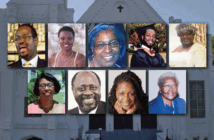Lewis Center Director Doug Powe says we all have characteristics that others recognize but we can’t quite see in ourselves. Effective leaders see past these blind spots by cultivating self-awareness, seeking accountability, and soliciting meaningful feedback.
How many times have you attempted to cross a lane of traffic and ended up with a horn blaring in your ear? Almost every driver has had this experience because of the “blind spot” — that danger zone where other vehicles can approach unseen unless you turn your head to look for them. Just as we have a blind spot while driving, we also have blind spots when it comes to leadership — those traits or characteristic that diminish our leadership capacity that others see but we cannot quite see in ourselves.
To complicate things even further, the very trait or characteristic that we are blind to may be a strength as well as a weakness. How can such a contradiction exist? Let me give an example. Hall of Fame quarterback Brett Favre, who played most of his years in pro football for Green Bay, was known to be brash and daring. Even if his receiver was double covered, Favre believed he could throw the ball so the receiver would catch it. Sometimes, Favre did in fact make a great play and hit his receiver. But there were also times that Favre threw interceptions when he threw into double coverage. His brashness was a gift that enabled him to make great plays, but it was also a blind spot causing him to throw interceptions.
Most leaders are like Favre. Their greatest strengths can also be their greatest weaknesses. And church leaders are not exempt. A characteristic or trait, such as being a risk-taker, will garner praise when it leads to something successful but invite criticism when it is seen as having contributed to a failure. The characteristics or traits that can help a leader excel are the same ones that may cause harm.
How can we as leaders be cognizant of our blind spots? Let me highlight three helpful ideas to keep in mind.
1. Self-awareness
Let’s say I am a person prone to speaking my mind. There are some situations in which the ability to be honest and direct is a strength and other times in which bluntness is detrimental. I need to cultivate enough self-awareness to indulge my tendency for frankness only when it is called for and curb it when it is not.
We become self-aware by being honest with ourselves about such characteristics and how our strengths can also become blind spots. For example, if I am a hands-off leader who lets others do their own thing, I need to be honest and accept that one of my blind spots is the possibility of veering off course because I’ve assumed others will adhere to the mission and regulate their own performance. Acknowledging this blind spot makes me more cognizant of the need to keep the whole team focused on achieving the mission.
2. Accountability partners
We all need someone or a group of people who can speak the truth to us in love. These individuals are honest enough to say when our risk-taking is over the top and not moving the congregation forward in a helpful manner. The key is to find an accountability partner or group that has our best interest at heart and is also willing to be honest in identifying the blind spots we do not see.
3. Objective and comprehensive feedback
You may feel that you are constantly getting feedback on your leadership. But that feedback isn’t very helpful if it takes the form of polite flattery or random criticism. Leaders need comprehensive and objective feedback to identify their blind spots and lead past them. A 360-degree leadership assessment instrument such as LPLI, the Lewis Pastoral Leadership Inventory™, is a helpful way of getting honest and candid feedback from a range of different perspectives. A 360-degree assessment or something similar that includes many different voices can help shine a light on those blind spots often hidden from a leader’s view.
The goal is not to ask others to give you glowing marks or report just the things you do well. The goal is honest feedback from those most familiar with your leadership so that you can identify those areas where your perception of your strengths and weaknesses does not match what others experience. It does not mean having to drastically remake one’s self. It does mean growing in self-knowledge.
We all have blind spots. But we don’t need to continue ignoring them. Effective leaders cultivate self-awareness, seek accountability, and solicit meaningful input from others to see their blind spots. Identifying our blind spots doesn’t necessarily make they go away. But it makes us cognizant of their impact on our leadership.







